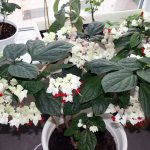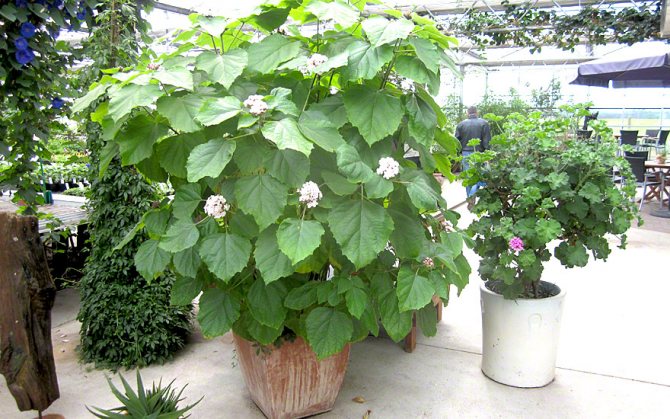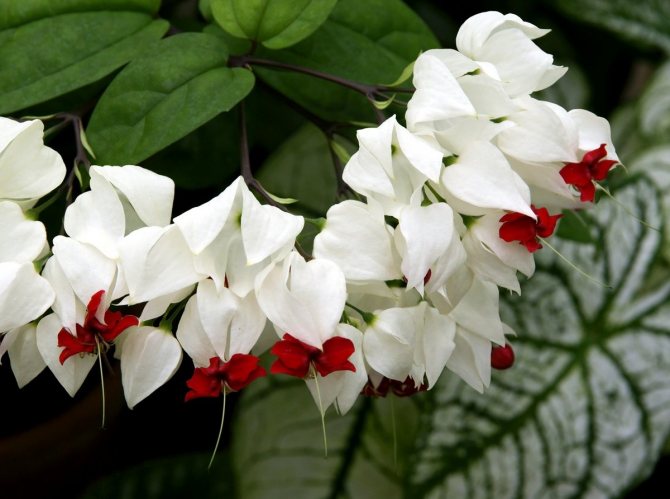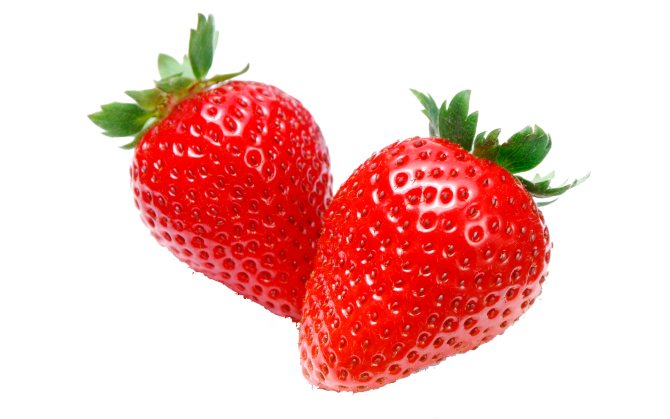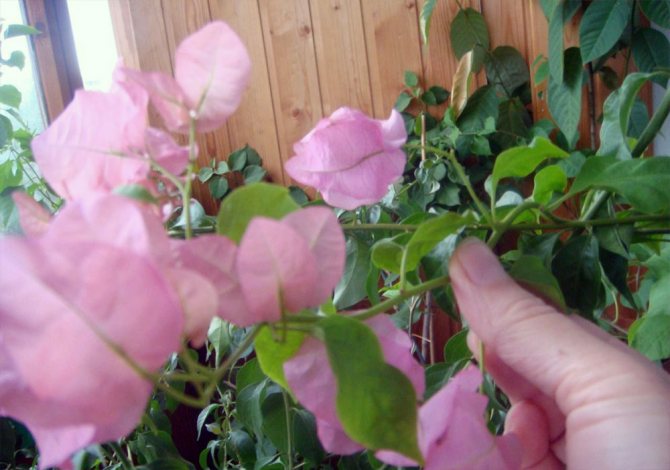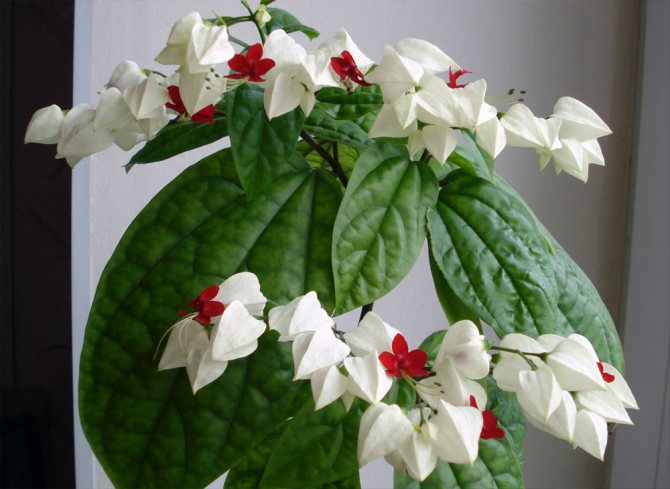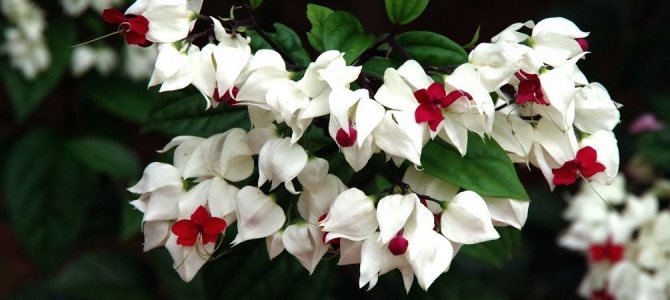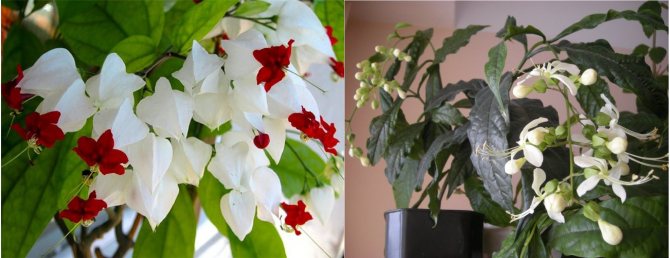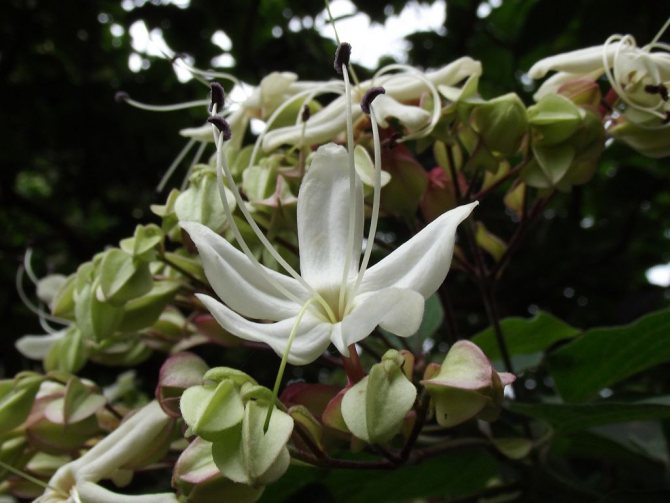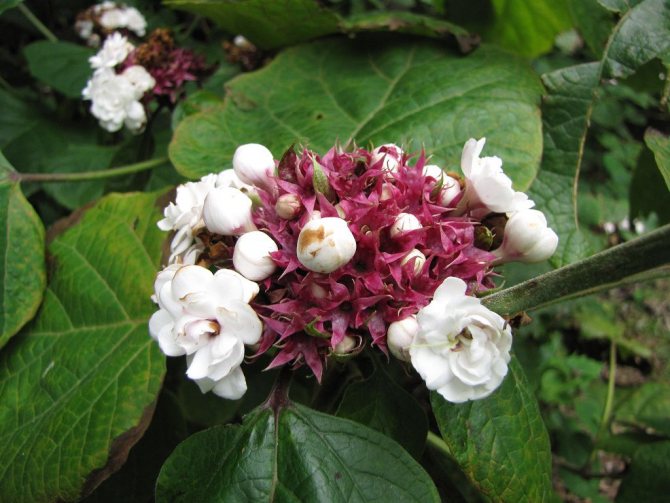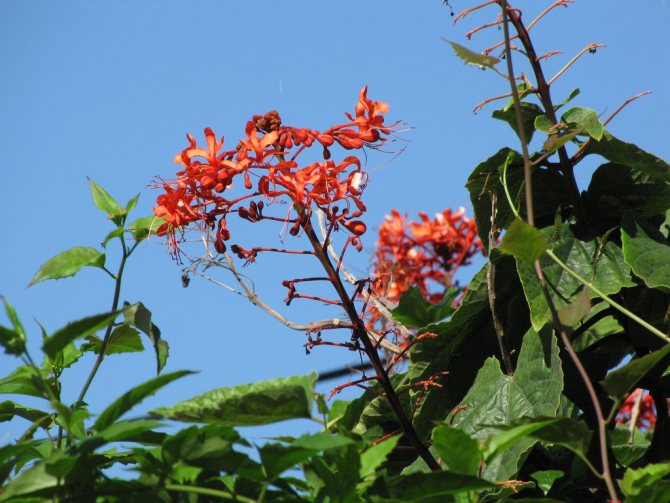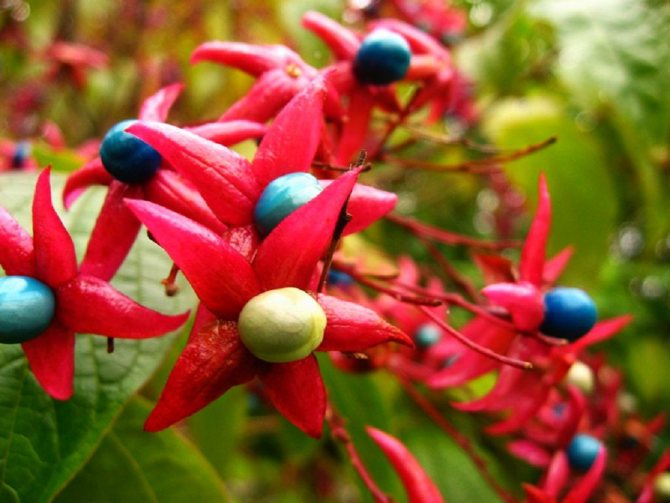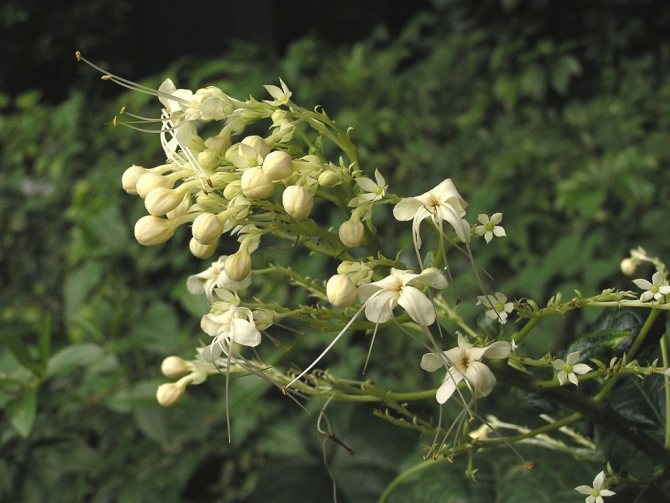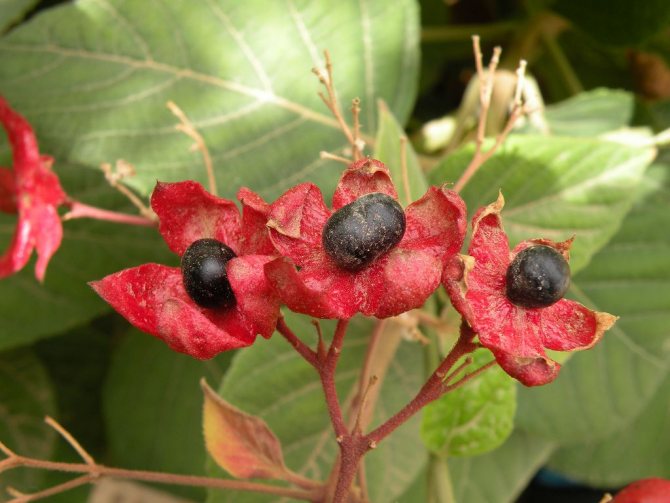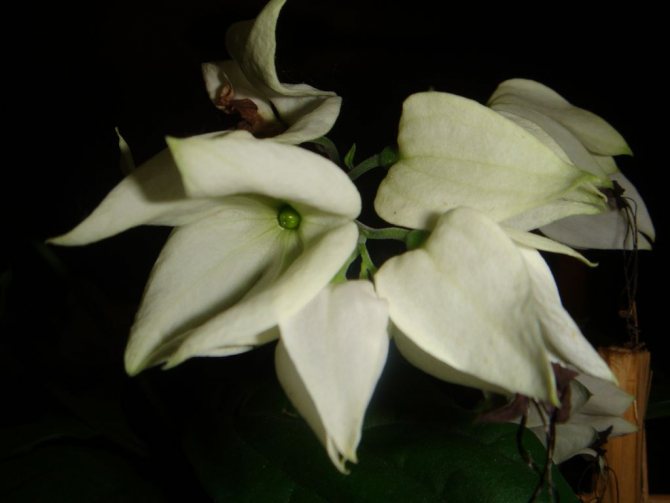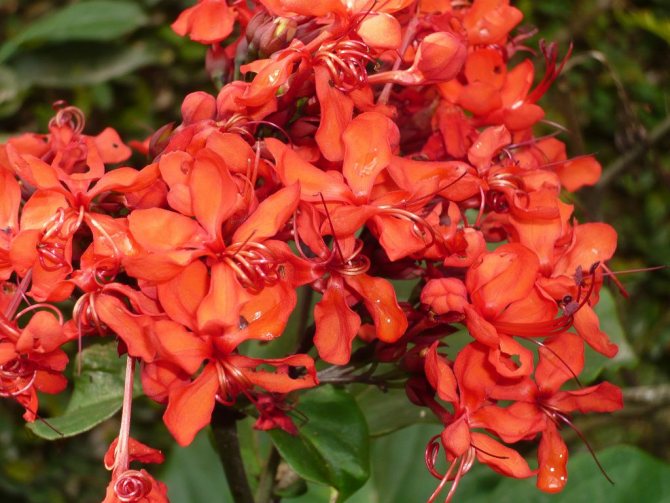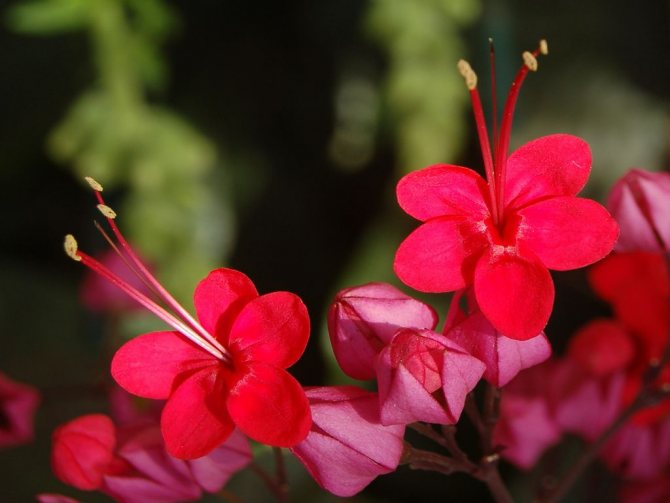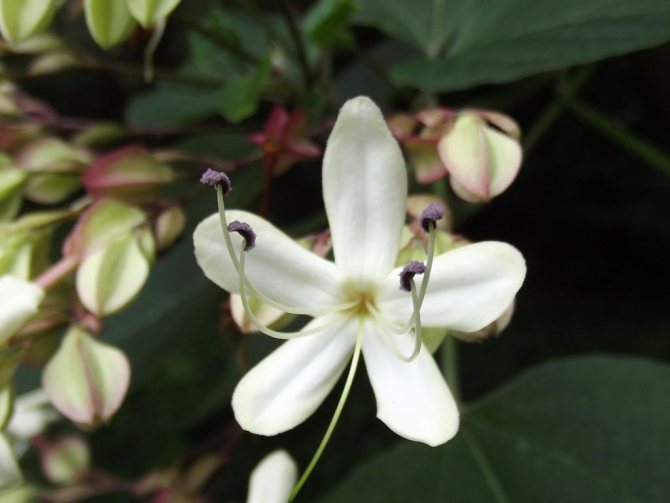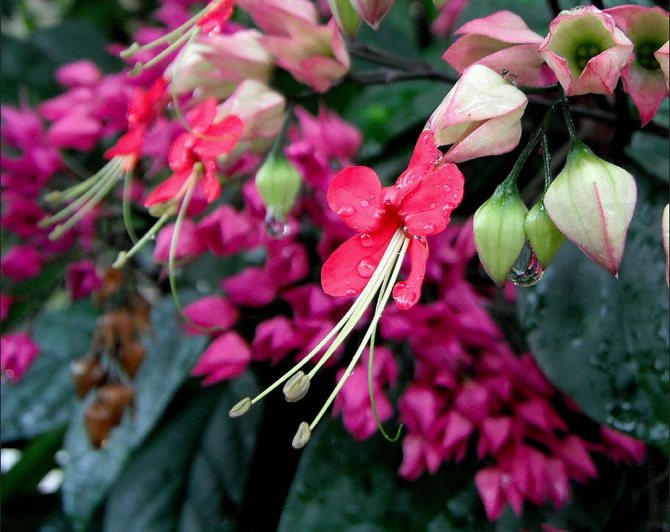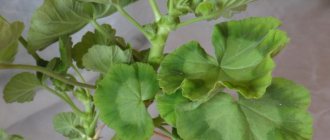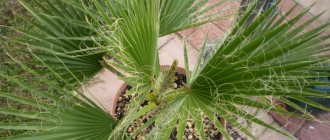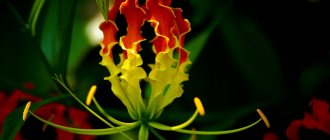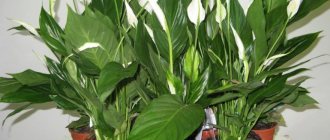Clerodendrum is one of the brightest indoor plants. Only a few people still consider it street. They cannot achieve flowering, so they prefer to refuse to grow it. It is worth asking for professional advice, so that later you can calmly grow an amazing flower on your own windowsill.
Content
- Listen to the article
- Growing features
- Caring for clerodendrum at home How to care
- Bloom
- Pruning clerodendrum
- Clerodendrum transplant
- Seed propagation
- Clerodendrum does not bloom
- Clerodendrum thomsoniae
Briefly about the plant
Clerodendrum is a green vine with beautiful weaves. In translation, a flower means "the tree of fate." The people may call it "innocent love."
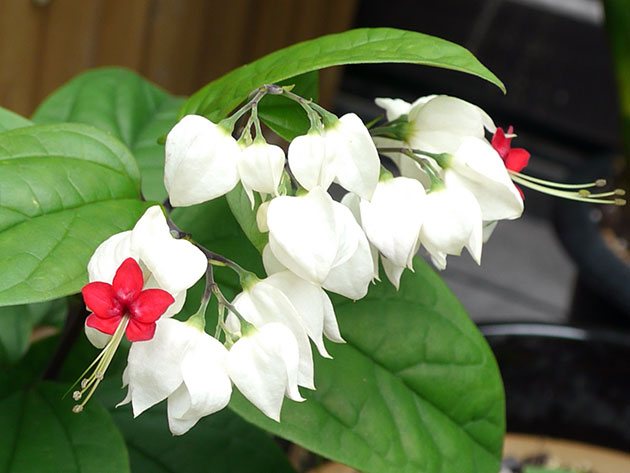
Thomson's Clerodendrum.
The homeland of lianas can be called Africa and Asia. The leaves of the plant are shaped like a heart, the inflorescences have the appearance of a panicle. There are many species of this flower in nature, and each of them has its own unique and amazing aroma.
Planting and caring for clerodendrum
- Bloom: from June to early autumn, fragrant clerodendrum blooms almost all year round.
- Lighting: bright diffused light (east and west windowsills, shading is required on the south window).
- Temperature: 18-25 ˚C during active growth and flowering, 13-15 ˚C during dormancy.
- Watering: abundant, the top layer of the substrate should dry out between waterings.
- Air humidity: increased, requiring nightly spraying in the warm season and keeping away from heating appliances in winter.
- Top dressing: from mid-spring to late summer, twice a month with complex mineral fertilizers for flowering plants.
- Rest period: after the end of flowering - in autumn and winter.
- Cropping: at the beginning of the growing season.
- Transfer: at the beginning of active growth: young plants are transplanted annually, adults every 2-3 years.
- Reproduction: seeds and cuttings.
- Pests: aphids, whiteflies and spider mites.
- Diseases: chlorosis, rot.
Read more about the cultivation of clerodendrum below.
Watering rules
In order for the flower to bloom as beautifully as shown in the photo with clerodendron, care and cultivation also implies compliance with certain watering rules. It is necessary to water this culture abundantly, while using soft, settled water. Before watering procedures, the top layer of soil in the pot must dry.
During the dormant period, the soil is moistened according to the following principle: the cooler it is in the room, the less often the flower should be watered, but in no case should the earthen lump dry out completely.
Clerodendrum flower - cultivation features
- Clerodendrum leaves, bright green, simple, cordate, with jagged or whole edges, rough "quilted" surface, 20 to 30 cm long, opposite or whorled on the stem. Flexible shoots in the lower part woody very quickly. The indoor flower clerodendrum is grown for its beautiful flowers with long stamens, collected in terminal scutes or brushes.
- Clerodendrum flowers in most species are butterfly-shaped, but in Clerodendrum Filipino and Clerodendrum benge, the inflorescences resemble bouquets of unusual shapes.
- Both flowers and leaves of most of the clerodendrum exude aroma, and each species has its own.
- The indoor flower Clerodendrum is represented mainly by two species - Thompson's Clerodendrum and Brilliant Clerodendrum, although other members of the genus grow well at home.
- Clerodendrum can be given various forms (ampelous, bushy, standard) using pruning and pinching.
- Caring for clerodendrum flowers is not difficult - they are hardy, unpretentious and at the same time fabulously beautiful and, moreover, fragrant.
When and how does bloom happen?
ATTENTION: The plant begins to bloom in early June. The end of flowering is usually in September. But there are species of lianas that can bloom all year round.
These beautifully flowering vines are rich in a variety of inflorescence shapes. and have a multifaceted palette of colors. For example, Thompson has bright white and crimson flowers. The Beautiful Clerodendrum has purple flowers, collected in paniculate inflorescences. And Fragrant blooms with fluffy white-pink flowers and its flowering, with proper care, continues all year round.
Caring for clerodendrum at home
How to care for clerodendrum
For healthy growth and full flowering, a tropical forest plant needs conditions that are as close to natural as possible. Clerodendrum at home prefers sills of windows facing south, west or east - it needs bright light, but with protection from direct sunlight. The temperature in the summer period is optimal in the range of 18-25 ºC, during the dormant period, which falls on the winter months, the plant needs coolness - no higher than 15 ºC.
The air humidity in the room with the clerodendrum should be elevated, so you will have to sprinkle the plant every night with soft, settled water in the warm season, and in winter, remove the flower pot away from heating appliances.
Watering the clerodendrum should be abundant, with soft water, but between waterings, the topsoil should dry out. During the rest period, the soil is moistened according to the following principle: the cooler it is in the room, the less often we water it, but the earthen lump should not dry out completely. From mid-spring to the end of summer, twice a month, the clerodendrum is fertilized with complex fertilizers for flowering indoor plants; in autumn and winter, additional fertilizing is not needed.
- Fatsia - care, photos, views
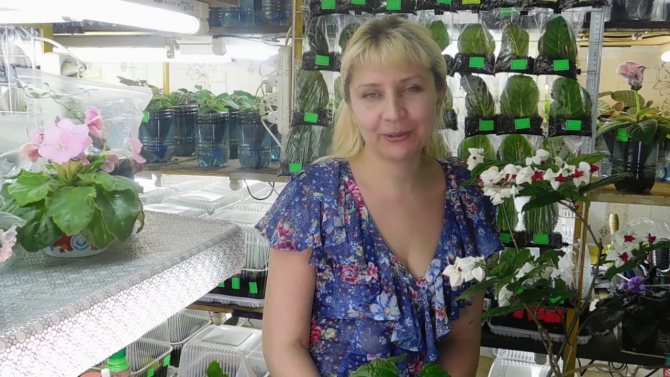

Flowering clerodendrum
The flowering of clerodendrum begins, depending on the species, from June, and these plants fade in September. It is interesting to observe how white bracts appear on the still bare shoots of Thompson's Clerodendrum in early spring, from which crimson corollas up to 2.5 cm in diameter are formed. Clerodendrum beautifully blooms from June to September with panicles of purple flowers, and fragrant clerodendrum blooms almost all year round. Anyone who has seen the flowering of clerodendrum will definitely want to see this magic again.
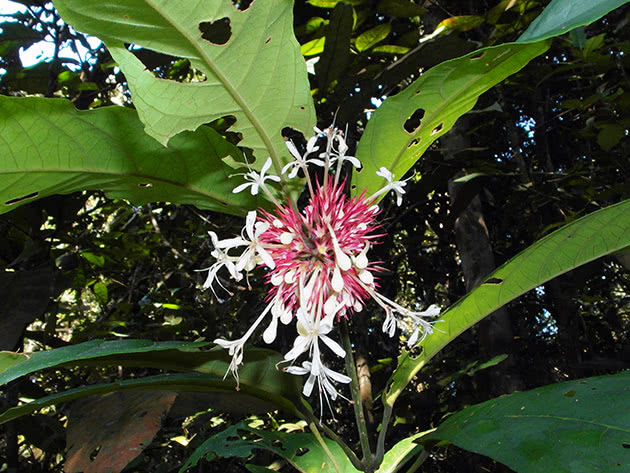

Pruning clerodendrum
Caring for clerodendrum involves the obligatory annual pruning of the plant at the beginning of the period of active growth. Caring for Thompson's clerodendrum, for example, in addition to removing dried or weak branches, requires shortening all shoots by a third of the length, which should stimulate abundant flowering, as well as intensive growth and branching of young lateral shoots, on which inflorescences are formed.The clerodendrum is pruned and in order to form the crown - if you want the clerodendrum to grow as a bush, you need to greatly shorten the shoots during spring pruning, otherwise you will have to install a support for them later.
How to prune a clerodendrum to make a tree? The stamp form is created as follows: all shoots are removed, except for one, the strongest, which is cut off at a height of 50-70 cm, and then all shoots appearing in the top area are pinched in order to create a crown due to their branching. If sprouts appear on the stem below the crown, they are removed.
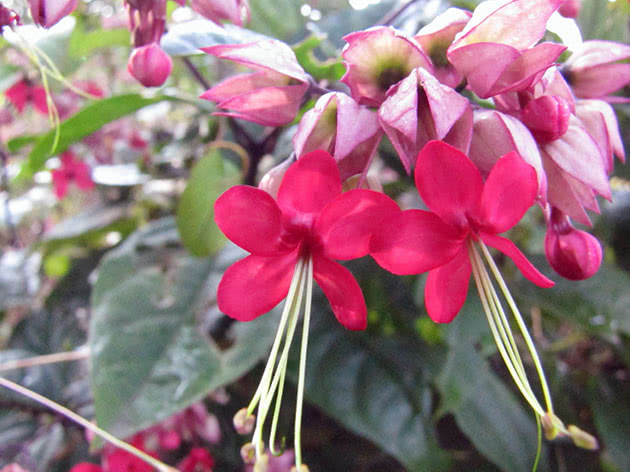

Clerodendrum transplant
Growing a clerodendrum requires replacing the old soil with a new one from time to time, in addition, an overgrown plant may require a larger pot. Plants are transplanted at the beginning of active growth after pruning. Young plants need an annual transplant, and for those that are older, it is enough to change the soil and pot once every two to three years. The soil for clerodendrum should be nutritious and slightly acidic (pH 5-6). You can use the soil purchased in the store, adding sand to it, or make it yourself from peat, coarse sand, sheet and clay soil in equal parts.
Before replanting the plant, the new soil must be disinfected by steam, in the oven or microwave. How to transplant clerodendrum? Take a pot 2 cm in height and 2 cm in diameter larger than the old one, put a layer of drainage three centimeters high in it and transfer the plant from the old flowerpot to a new one, being careful not to damage the root ball. Add the required amount of new substrate to fill the voids in the pot and water the plant. If your clerodendrum needs support in the future, dig it in during transplanting so that later you do not have to stick it into the pot, damaging the roots of the plant.


Temperature and humidity
In the summer, the plant should be kept in a room where the air temperature is from 18 to 25 degrees. During the dormant period, which lasts during the winter months, the culture needs coolness. To do this, the flower should be kept in a room where the air temperature will not exceed 15 degrees. These are the features of care.
Clerodendron, the photo of which is presented above and below, also needs to provide a certain humidity in the room. This culture prefers to grow in high humidity, so it is necessary to spray the flower with settled soft water every day in the evenings in the spring and summer. With the onset of winter, the plant should be removed away from all heating appliances in the apartment.
Reproduction of clerodendrum
Reproduction of clerodendrum at home is carried out both by generative (seed) and vegetative (cuttings) methods.
- Why the Chinese rose doesn't bloom
Reproduction of clerodendrum by seeds
Clerodendrum seeds are sown in late February or early March in a mixture of turf, sand and peat, placed in a greenhouse and kept in good light, ventilating and maintaining a moderate soil moisture. It will take a long time to wait for seedlings - one and a half to two months. When the seedlings have four true leaves, they are dived into separate small containers with a diameter of 6 cm, one seedling each or three each in a container with a diameter of 11 cm, and as soon as the seedlings get used to and grow, they begin to accustom them to the conditions for adult clerodendrum.
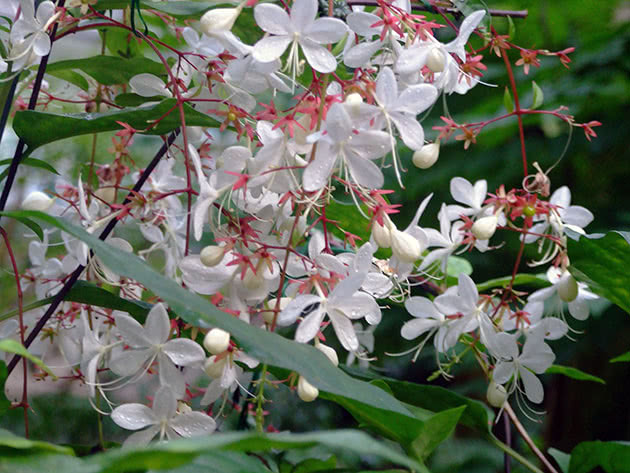

Reproduction of clerodendrum by cuttings
If you already have clerodendrum, you will not need a seed propagation method, because you can always get a cutting for rooting with spring pruning. Clerodendrum cuttings root easily in water, especially in spring and summer. Rooted cuttings are planted in pots with a diameter of about 7 cm and grown under a glass cover, keeping the substrate moist.
As soon as the root system develops, and the cutting has shoots and leaves, the cutting with a root ball is transferred into a pot with a large (9 cm) diameter, in which it will grow until spring without a cap. After a year from the beginning of rooting, transfer the plant into a pot with a diameter of 11 cm into the soil for an adult clerodendrum. During this time, be sure to pinch the shoots at least twice to stimulate the growth of the side branches.
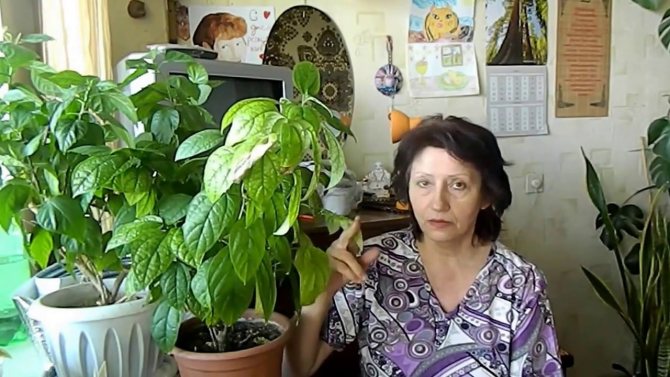

Transfer
Why do the leaves of indoor flowers turn yellow - what to do
It needs a transplant every year, since the root system is very developed and growing rapidly. More often than not, it looks more like a transshipment than a transfer. The roots of the plant are very delicate, it is better not to touch them.
Note! It is impossible to strongly rid the roots of the soil, since they can be damaged, which can also cause the lack of flowering.
The flower is picky about the soil: you need a nutritious slightly acidic earth. To create these conditions, you need to mix in equal parts:
- clay soil;
- leafy soil;
- peat;
- coarse sand.
Note! Before transplanting, the soil is disinfected with steam or in an oven.
Pests and diseases of clerodendrum
Of all the harmful insects, spider mites and whiteflies can infect clerodendrum. Whiteflies hide on the underside of the leaves, and on the upper one there is a shiny bloom from whitefly feces - honeydew, or honeydew. The spider mite is too small for you to see, but it shows up with white dots on the underside of the leaf blade and a barely visible cobweb on the leaves. You can fight these pests with the same insecticide: dilute one ampoule of actellik in a liter of water and spray the plant. The treatment can be repeated four times at intervals of three days.
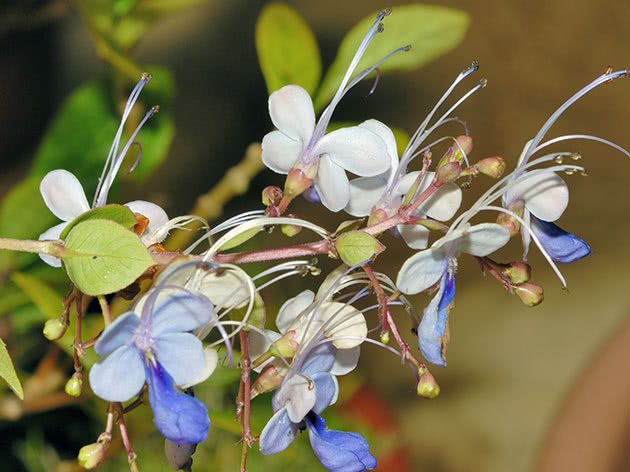

Clerodendrum does not bloom
Very often, on flower forums, beginners try to find out from experienced flower growers why their clerodendrum does not bloom, and each time they are amazed at how simple the reason for their sadness is. Moreover, when they are convinced that everything depends only on them, and get down to business, then the problems with other colors are solved by themselves. And the reason is always the same: the rules for growing a plant were violated. In the case of clerodendrum, most often flowering does not occur due to improper wintering of the plant.
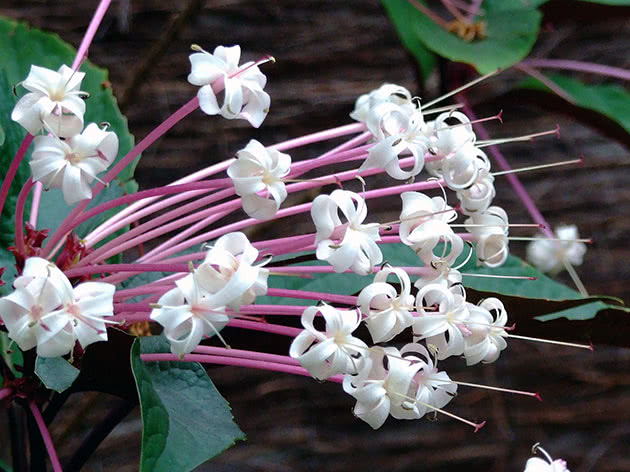

How to make clerodendrum bloom
So what if Clerodendrum is not blooming? In order for your clerodendrum to bloom in the spring, it needs to organize a cool winter. Once flowering is over, gradually reduce watering to the plant and move the flower to a cool - no warmer than 15 ºC - room. Optimal conditions for wintering are 12 ºC and purely conditional watering just to keep the plant from drying out. With this content, within one and a half to two months, the clerodendrum will rest and gain strength for a new season of active growth.
As soon as you notice that the clerodendrum has begun to release new shoots, gradually increase the watering, prune and, if necessary, transplant the plant, transfer it to its usual place and resume feeding. Make sure that the soil near the clerodendrum is nutritious - sometimes the plant does not bloom due to the fact that it has not been transplanted for a long time. Another reason for delayed flowering and even dropping of buds can be insufficient lighting.
- Why does the Chinese rose fall
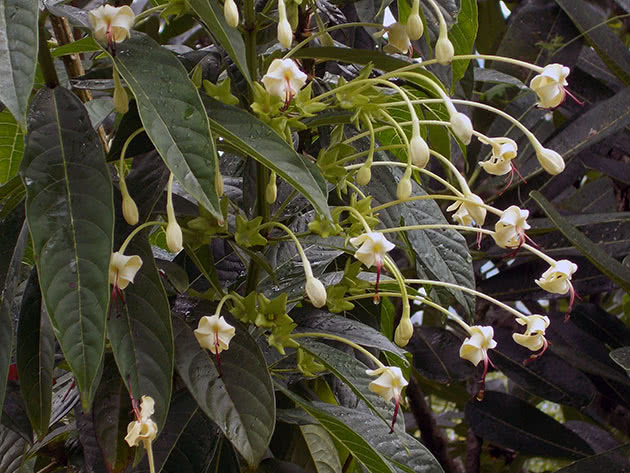

Clerodendrum turns yellow
If clerodendrum leaves turn yellow in spring or summer, then the reason may be a lack of moisture in the soil - water the plant more often or more abundantly so that there is always water in the pan. Sometimes the cause of yellow spots on the leaves of clerodendrum is chlorosis, which is cured by feeding the plant with iron-containing preparations.
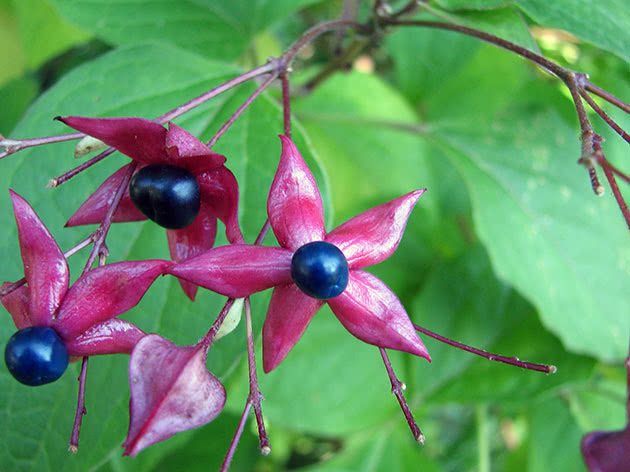

Clerodendrum leaves fall
If leaf fall begins after flowering, then most likely this is a natural autumn process for deciduous - the leaves turn yellow and fall off all autumn and winter, leaving bare shoots.But in spring and summer, the leaves should not fall off, so re-read the rules for caring for the plant and correct your mistakes or change the location of the clerodendrum.
Lack of flowering
In some cases, this crop does not bloom. As a rule, this is due to improper cultivation and care. A photo with an indoor flower clerodendrum shows how beautiful this culture can bloom. However, the absence of flowering in most cases is observed due to improper wintering of the plant.
But what if the plant doesn't bloom? In order for a flower to bloom with the arrival of spring, it needs a cool winter. As soon as flowering comes to an end, watering should be gradually reduced and the culture should be transferred to a cool room, where the air temperature will be no more than 15 degrees. Watering should be purely conditional so that the clerodendrum does not dry out. Under such conditions, the culture rests for two months and gains strength for a new period of active growth.
As soon as the flower begins to release new shoots, it is necessary to gradually increase watering, pruning, and transplanting as needed. The plant should also be transferred to its usual place and resumed feeding.
The soil at the clerodendrum must be nutritious. In some cases, the plants do not bloom due to the fact that they have not been transplanted for a long time. Another reason for delayed flowering is insufficient lighting. For the same reason, buds can also fall off.
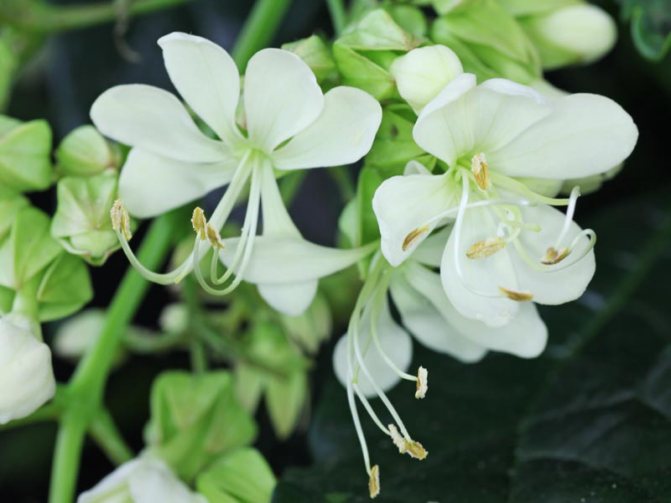

Types of clerodendrum
Clerodendrum thomsoniae
The most common type in indoor floriculture, it is a ligneous deciduous vine with smooth thin shoots. Dark green large dense leaves with distinctly protruding veins and solid edges have an oblong-ovoid pointed shape and reach a length of 12 cm. On the upper side of the leaf plate there are irregular spots of more and less light shades. White bloated flowers with a red corolla are collected in loose racemose inflorescences growing from the sinuses. Clerodendrum Thompson reproduces at home using cuttings, grows very quickly, blooms from March to June.
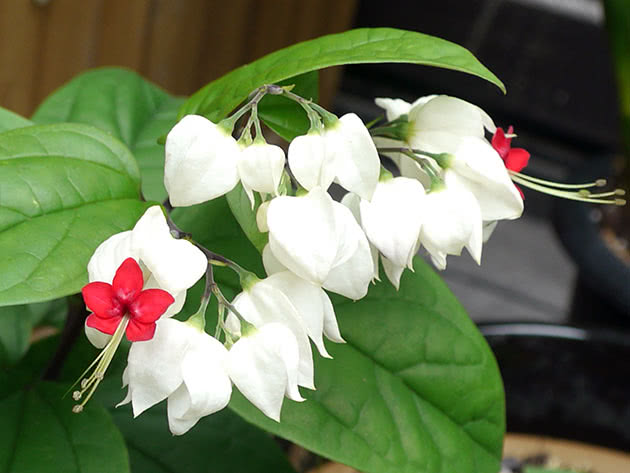

Clerodendrum splendens
It belongs to evergreen shrubs with curly shoots, almost round leaves up to 8 cm long and 6 cm wide, having a heart-shaped base, a pointed oblong top and wavy edges. Scarlet-red flowers are collected in short axillary racemose or corymbose inflorescences. Clerodendrum blooms brilliantly almost all year round.
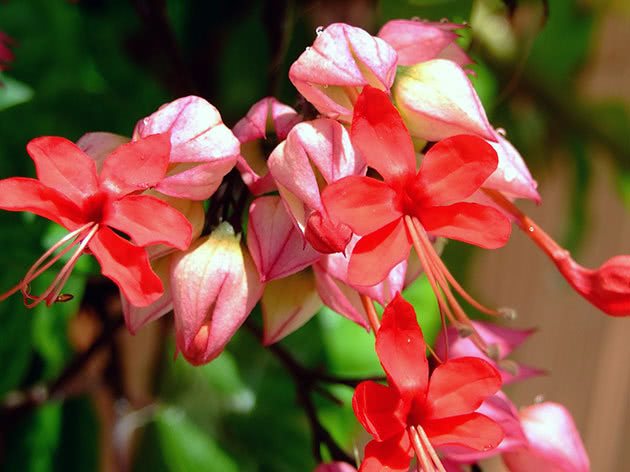

Clerodendrum philippinum
A species with a strong pleasant jasmine-vanilla aroma, which intensifies in the evening. This wonderful representative of the genus, unfortunately, is an infrequent guest in our apartments, although in care it is not capricious and blooms already in the second year of life with pinkish-white inflorescences up to 20 cm in diameter from pink flowers with a diameter of 2-3 cm, the beauty and tenderness of which are emphasized by wide dark green leaves.
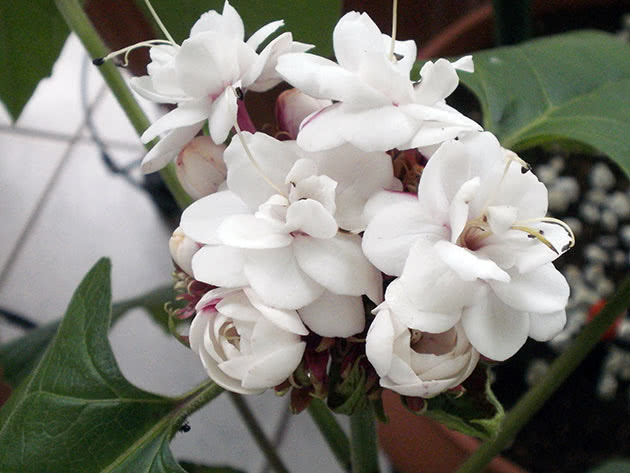

Clerodendrum ugandense
A fast-growing evergreen vine that can be up to two meters long. The leaves are dark green, broadly lanceolate, the flowers are collected in loose terminal few-flowered inflorescences and with blue filiform stamens resemble butterflies with antennae. The upper and side petals of the flowers are blue, and the lower, barely noticeable petal is lilac-blue or violet. This clerodendrum can be shaped both as a bush and as a tree.
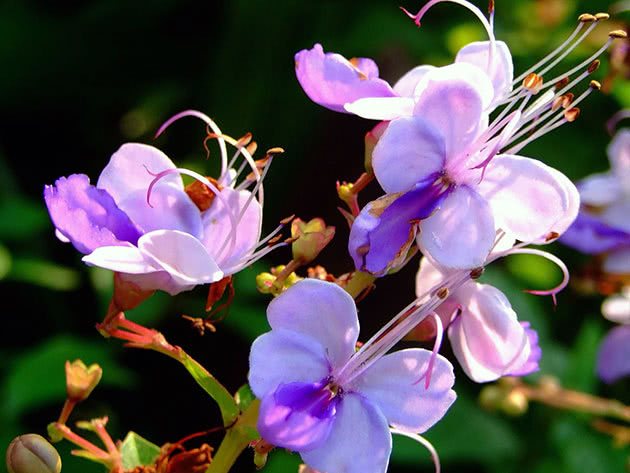

Fragrant Clerodendrum (Clerodendrum fragrans)
Evergreen shrub up to two meters high. On pubescent shoots, broadly ovate, with deep teeth along the edges, the same pubescent leaves up to 20 cm long grow.White with a pink tint on the outside, simple or double flowers, exuding aroma with notes of violets and citrus, collected in dense apical shields up to 8 cm in diameter ... This species blooms almost without ceasing.
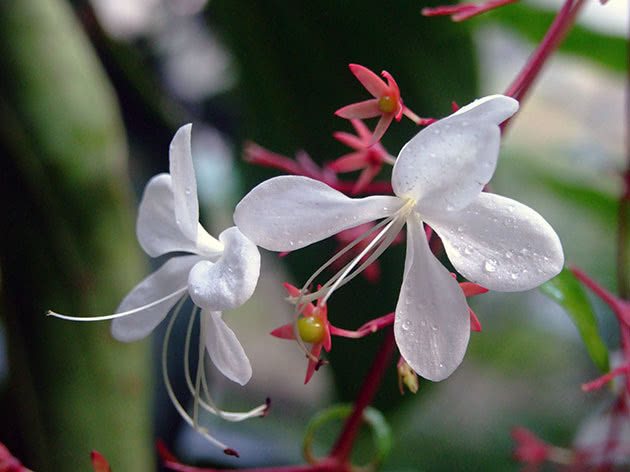

Wallich's Clerodendrum, or Prospero's Clerodendrum
And also "Cleopatra's tears", "bride's veil" or "bride's veil", as this species is called among the people, is distinguished by abundant flowering of snow-white inflorescences made of flowers of exquisite shape. The plant itself is a small graceful bush with tetrahedral shoots and dark green lanceolate leaves 5-8 cm in length, with a wavy edge, which fits on the narrowest windowsill. This is the most difficult species to grow indoors, requiring special daylight hours and high humidity.
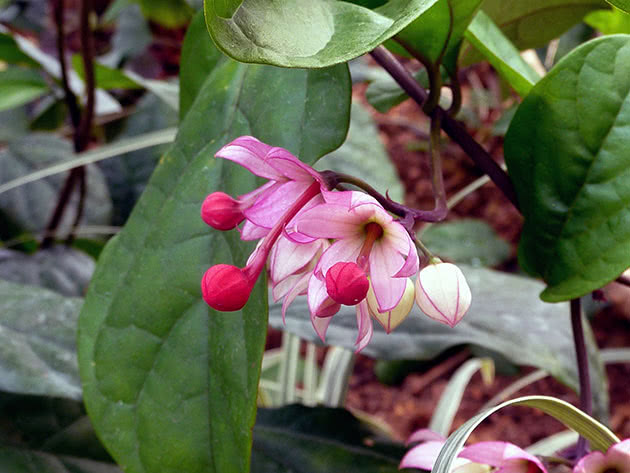

Varieties of indoor plants
The most common varieties of this plant are as follows:
- Clerodendrum Thompson. This type of indoor clerodendrum is the most common. It is a deciduous ligneous vine that has smooth, thin shoots. The culture blooms with white swollen flowers, which have a red corolla. They gather in loose racemose inflorescences that grow from the sinuses.
- Clerodendrum is brilliant. This variety belongs to evergreen shrubs, which have curly shoots, rounded leaves. This variety blooms almost all year round.
- Clerodendrum Filipino. This species has a very pleasant honey aroma, which intensifies with the arrival of the evening. Unfortunately, this species is an infrequent guest among indoor crops, although plant care is considered quite simple.
How to prune
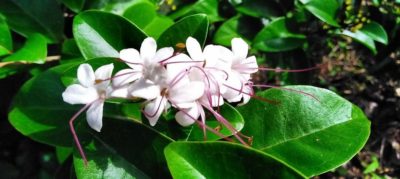

Some hobbyists are wondering if the plant needs pruning. Volcameria grows quickly without pruning and reaches gigantic proportions without leaving. Pruning is carried out in the spring, shortening to a third of the length of the shoots.
The ends of the sprouts are pinched during the procedure. Volcameria can become a flexible vine, shrub, or tree. Pruning rejuvenates the plant, increases its decorative effect and makes young shoots bloom.
Remove stepchildren, dry, diseased, damaged shoots during the entire growing season. If the cut pieces have two growth slices, they can be used in cuttings.
If the clerodendrum grows in open ground, the shrubs are cut off, and additional supports are made for the vines. For the formation of the stem, the strongest stem is selected and the lateral processes are cut off. When the height is reached to the mark of 50 cm, pruning is carried out, and then young shoots are pinched.
This is how a beautiful tree is formed, from which the lower processes starting from the root collar are regularly cut off.
What should be the lighting in the room
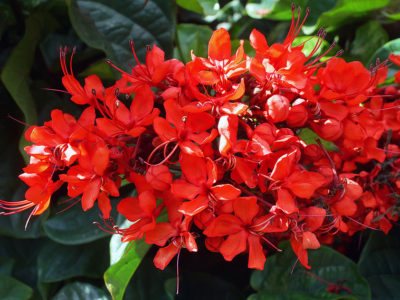

Volkameria is unpretentious, tolerates light and partial shade well. Florists recommend placing it in a shaded place, where direct sunlight does not fall.
Please note: it is better to place the flower on the west or east side. On the north side, it will lack light, which will negatively affect flowering.
In this case, use phytolamps to increase the brightness and duration of daylight hours.
Plant appearance, growing area
Clerodendrum is a liana-like tree or shrub plant. It is distinguished by lush and long flowering. The name of the flower has Greek roots, and it translates as "tree of fate." According to the beliefs of the aborigines of the island of Java, the branch of the plant is a magic talisman, an amulet that can change the life of its owner and provide him with the opportunities that he has long dreamed of.
The plant gained popularity in Europe in the middle of the nineteenth century. At this time, it was grown in greenhouses and flower gardens. Over time, breeders became interested in him. They crossed different species and got new, beautiful plants.
Clerodendrum - represents the Lamiaceae family and grows in Asia, Africa, Latin America, the Indian Ocean islands and Australia. There are evergreen and deciduous species. Vines reach up to four meters in height, and shrubs up to two.
Volcameria has a tetrahedral stem, olive, or reddish-brown skin, and bright emerald, opposite leaves. The leaf blades are different in shape and depend on the variety. In total, three forms of plant leaf blades are distinguished:
- heart-shaped;
- oval;
- ovoid.
Leaves grow up to 20 cm long, and the edges can be smooth, or with small teeth. On the surface of the plates there is a distinct venation, deepened along the central and lateral veins.
The inflorescences consist of small, beautiful flowers at the tips of the shoots or in the leaf axils. They have a scutellous or paniculate structure. Long peduncles give them elegance and make them look like lush bouquets.
The cups have a bell shape and are divided into five lobes, their diameter reaches 2.5 cm. The corolla is painted in contrasting tones, and long (up to 3 cm) and thin stamens grow from its center.
Volcameria usually blooms from April to September and smells good. It is interesting that not only flowers, but also leaves smell, and each has a unique aroma. Large bracts remain on the bush until the dormant period, which gives the impression that the plant is constantly blooming. After flowering, oblong orange fruits, up to 1 cm long, grow on most species. They have only one seed.
Possible difficulties
Clerodendrum has excellent immunity and, extremely rarely, with prolonged improper care, suffers from fungal diseases. He is not afraid of other ailments.
Of the parasites, the plant is attacked by spider mites and whiteflies. Most often, insects breed in too dry air. Modern insecticides will help you quickly get rid of them. The treatment is carried out in batches of 2-3 times with an interval of 4-7 days.
Sometimes the appearance of the clerodendrum becomes unsatisfactory due to mistakes in care:
- leaves turned yellow and withered - insufficient watering;
- brownish spots on foliage - sunburn;
- the leaves dry from the edge and fall off with the buds - the air is too dry;
- internodes are too long, and shoots are bare - lack of lighting.
Sometimes flower growers cannot wait for fragrant buds on the clerodendrum for a long time. The lack of flowering is usually associated with an improperly organized dormant period (warm wintering). Also, a lack of fertilizers or an excess of nitrogenous fertilizing can become a problem. You just need to transplant the flower into the correct soil, and in winter keep it at a temperature of + 12 ... + 15 ° C and already at the beginning of spring the first buds will be noticeable.
Related Articles
DIY champagne box
15.11.2019
Egg box for laying hens
15.11.2019
A box you can sit on
15.11.2019
DIY beekeeper box
15.11.2019
Orchis application in folk medicine reviews
15.11.2019
Yafon orchids official website
15.11.2019
see also
Care secrets
At home, the main difficulty in caring for clerodendrum is to create comfortable conditions close to natural.
Lighting. The plant loves bright, diffused light for 12-14 hours daily. It can be placed in the back of the south room or on the east (west) windowsill. Shading will be needed at noon. On the north window, the clerodendrum will not have enough light and will have to use phytolamps. Without her, flowers cannot be expected.
Temperature. Clerodendrum belongs to plants with a pronounced dormant period. From April to November, the optimum air temperature for it is + 20 ... + 25 ° C. On too hot days, you need to ventilate the room more often or expose the flower to the open air, but protect it from drafts. In winter, you need to provide the plant with a cool content (about + 15 ° C).
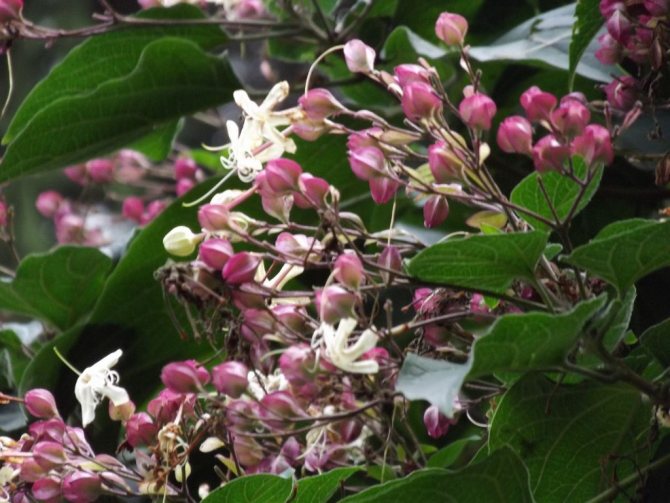

Humidity. High air humidity is vital for the plant. It should be sprayed several times a day, bathe regularly and wipe the leaves with a damp cloth. For water procedures, use well-purified, settled water so that ugly stains do not appear on the leaves. In winter, the clerodendrum should be placed as far away from heating appliances as possible.
Watering. Indoor flowers need regular but moderate watering. At one time, a small portion of soft water at room temperature is poured into the soil.In the spring and summer, only the top layer of the soil should dry out. In winter, the earth is allowed to dry out by half, but no more.
Fertilizer. Fertilize clerodendrum from March until the end of flowering three times a month. A solution of a mineral complex fertilizer intended for flowering plants is poured into the soil.
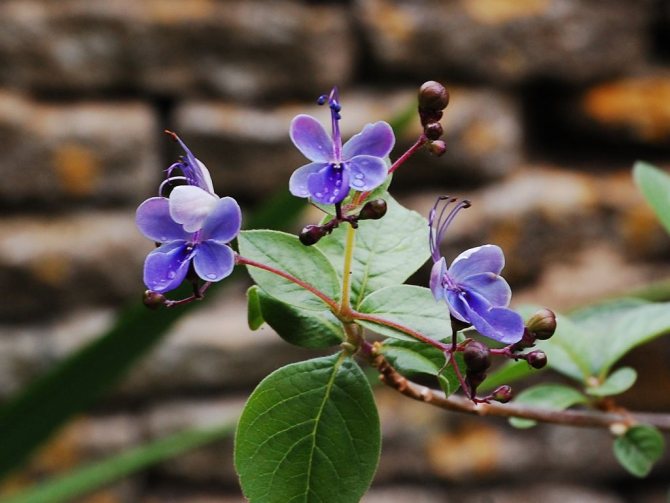

Transfer. The root system of the clerodendrum is quite fragile, so the transplant is carried out by the transshipment method. A deep pot is required for a tap root. At the bottom there is 4-5 cm of a drainage layer made of fragments of red brick, pebbles or expanded clay. The soil is composed of:
- sheet soil;
- clay soil;
- river sand;
- peat.
Pruning. Even in indoor conditions, the plant can reach impressive sizes. Fortunately, it tolerates pruning well and can take any shape (bush, tree or flexible vine). In the spring, cut off to a third of the length of the stems and pinch the tips of the shoots. The benefit of pruning is also that the flowers bloom on the young shoots. The resulting material is convenient to use for grafting.
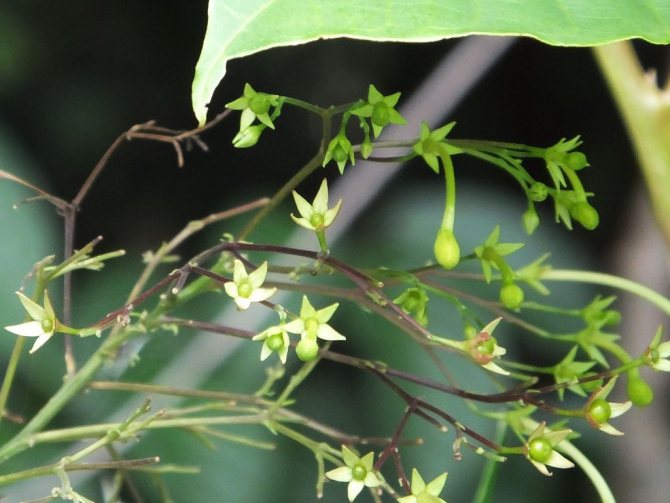

Yellowing and falling leaves
Quite often, with improper home care, the Filipino clerodendrum, a photo of which is presented in this article, or another indoor variety of this plant, is sick. His leaves begin to turn yellow in summer or spring. The reason for this lies in insufficient soil moisture. To get rid of this problem, plants should be watered as often or abundantly as possible. Please note that there must always be water in the pan.
Most rarely, the cause of the appearance of yellow spots on leaf plates is chlorosis. It can be cured by fertilizing with iron fertilizers.
If, after flowering, the flower has a leaf fall, then in most cases this is a natural process for deciduous crops. As a rule, foliage turns yellow and falls off throughout the fall and winter, as a result of which only bare shoots remain. However, in summer and spring, the leaves should not fall off. To avoid this, you should follow all the rules for caring for this plant.
In conclusion, it should be noted that caring for this room culture is very simple. To achieve flowering clerodendrum at home, you just need to adhere to the basic rules for growing this flower. Even inexperienced and novice growers can enjoy the beautiful flowers of this plant.
Disembarkation
Planting takes place according to certain rules. Before planting or replanting a flower, prepare a nutritious soil. It is necessary to mix several components in a 1: 1 ratio. The mixture consists of leaf humus, clay soil, river sand and peat. If the mixture cannot be prepared, you can make it easier and purchase a ready-made mixture at the store.
Please note: if you decide to prepare the soil yourself - do not add too much peat - a slightly acidic soil is needed for volkameria. Ready-made soil from the store, before hitting the shelves, went through all the stages of processing and can be used. The self-prepared mixture is disinfected before use. To do this:
- Clean the mixture of debris.
- Next, place a thin layer of the mixture on a baking sheet.
- Preheat oven to 200-220 degrees.
- When the oven is warm enough, remove the soil in it for 20 minutes.
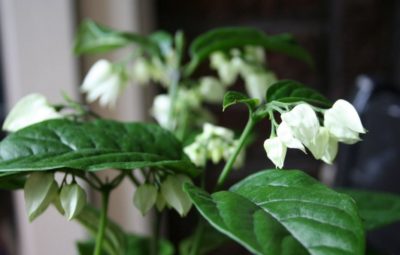

The second method is suitable if it is not possible to use the oven:
- Pour a small amount of water into a saucepan.
- Stretch thin, permeable material over it.
- Pour a thin layer of soil on top of it, turn on the fire.
- After boiling water, leave the soil for 10-5 minutes.
- Remove and add a new batch.
Mature plants are transplanted in the spring, as soon as they have moved away from dormancy and are preparing to build up green mass. The transplant is performed when the plant has grown strongly and can overturn the pot. To transplant, follow a few simple steps:
- Choose a large, stable pot that is about 4 cm wider than the old one.
- Fill the bottom with expanded clay or river pebble drainage. The layer thickness should be up to 3-4 cm.
- Add a layer of nutritious soil.
- Transfer the plant to a new pot by transferring the plant, keeping as much of the earthy clump as possible.
- Pour the missing soil around the edges and tamp a little.
- Place the plant in a moderately shaded area and moisturize after 2-3 days.
- Move the flower back to its original location and care for it as usual.
If volcameria has just been purchased, it can be transplanted at any time of the year. Important: take your time, she needs about 3 weeks to adapt before transplanting. Consider how to transplant a plant in this case:
- Shake the pot, separate the soil from the walls with a thin stick.
- Transplant the flower along with the clod, placing it in the center of the new pot.
- Top up with soil.
Please note: the first five years of the volcameria's life, it must be replanted annually. After six years - every three years.
Florist reviews
I immediately transplant all newly acquired plants and process them from pests. For clears, I take the ground teravita + coco-soil + vermiculite (by eye, so that the soil is light). I do not create any special conditions. I take small containers for transplanting, since until the root one has mastered the earthen lump, the top does not grow. Clores grow fast enough, do not get carried away with feeding. They bloom at the ends of the shoots, so pinch and trim as needed.
Fanya
This species is very fond of moisture and water. Moreover, this flower is immediately noticeable when it is “thirsty”. Its wide, slightly and rough emerald leaves droop and hang like rags. Clerodendrum in nature is a vine. Therefore, it intensively produces shoots that need support. If you want to form a tree, then the shoots must be cut off. In the summer, I take my clerodendrum to the balcony (he really likes it there) and allow it to sprout along special ropes. Also, pruning of shoots is needed in order for your flower to bloom. This happens, as a rule, closer to March. It blooms for a very long time, several months.
ElFeYa
I really want to start growing this plant. I am especially attracted to flowers. I know that red corollas usually fade before the cups. And then these cups change color to bright red and continue to decorate the clerodendrum for some time.
Madlen
Clerodendrum is very fond of warmth and good lighting. Also, the flower needs to be watered abundantly in the summer months and do not forget to spray.
Karol_ina
A very beautiful flower, for some reason not very common - it reproduces elementarily, by cuttings ... once I saw a plant on which one hundred and four flowers bloomed at that time - we were not too lazy to count))) believe me, it was a very impressive sight. I spread it in the office, almost in every office there was a pot with such a miracle, then I retired, the flowers began to wither and completely disappeared (((((and I didn't think to take at least one home - now I'm looking and can't find ((((the flower, by the way, perfectly tolerates pruning, you can shape the crown as you like)))))
ALLYENA
More reviews about Clerodendrum can be found on the website dacha.help
Why does not give buds: reasons
It often happens that Clerodendrum does not bloom.
In fact, there are not many reasons why a plant does not release buds. All of them are associated with mistakes in care and violations of the conditions for keeping the flower.
- The plant was not provided with dormant conditions in winter.
- The flower has not been transplanted for a long time.
- The soil lacks nutrients. Or there are too many of them.
author Lyudmila Ezhova


Winter garden of Lyudmila Yezhova
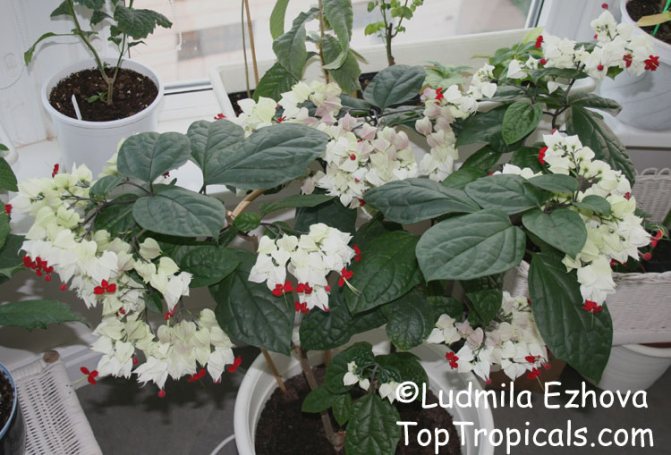

Clerodendrum thomsoniae


Clerodendrum bungei - fragrant Bouquet of Kashmir
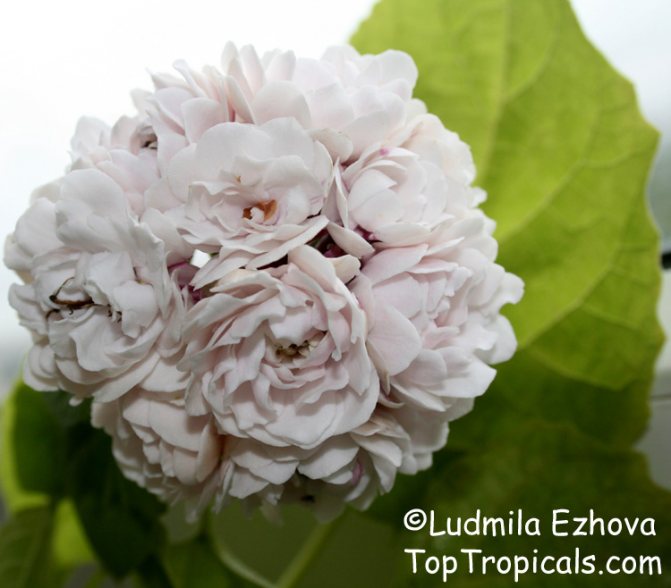

Clerodendrum philippinum - ready-made bouquet for the bride
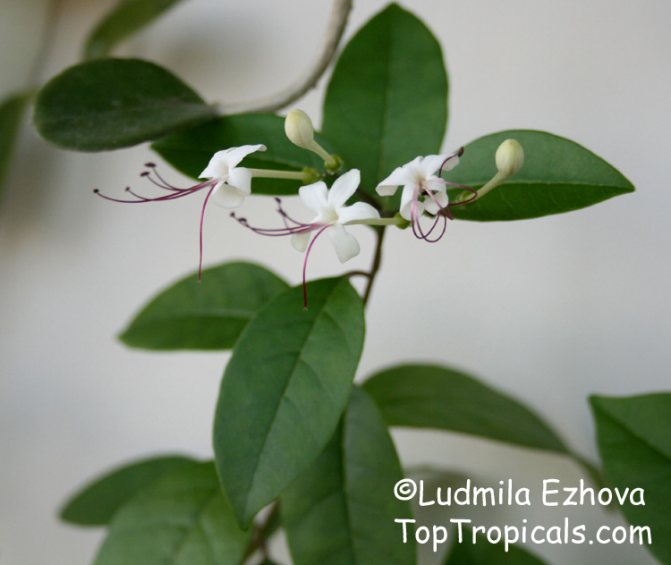

Clerodendrum inerme - bush form of clerodendron
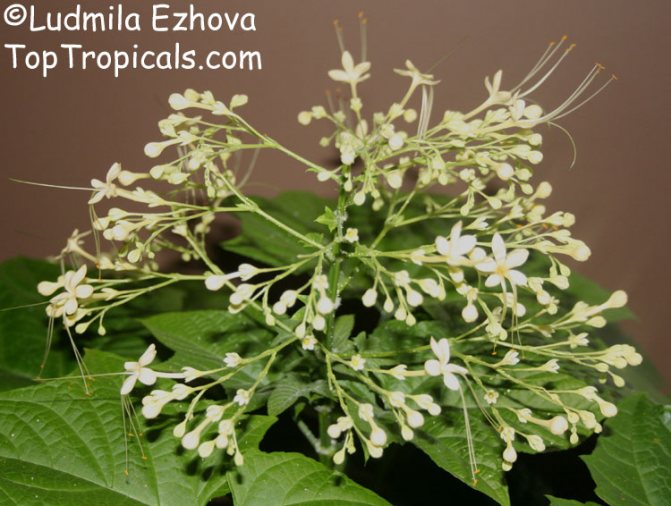

Clerodendrum paniculatum Alba
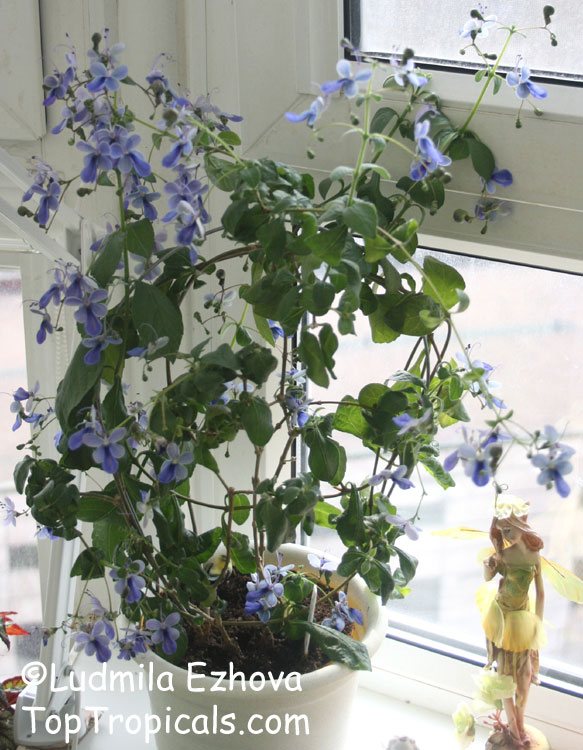

Clerodendrum ugandense
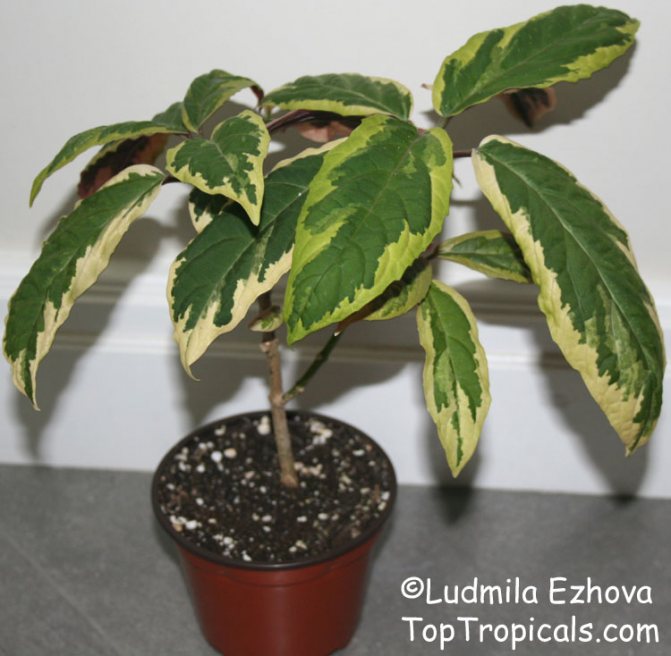

The flowering of Clerodendrum quadriloculare variegated is yet to come
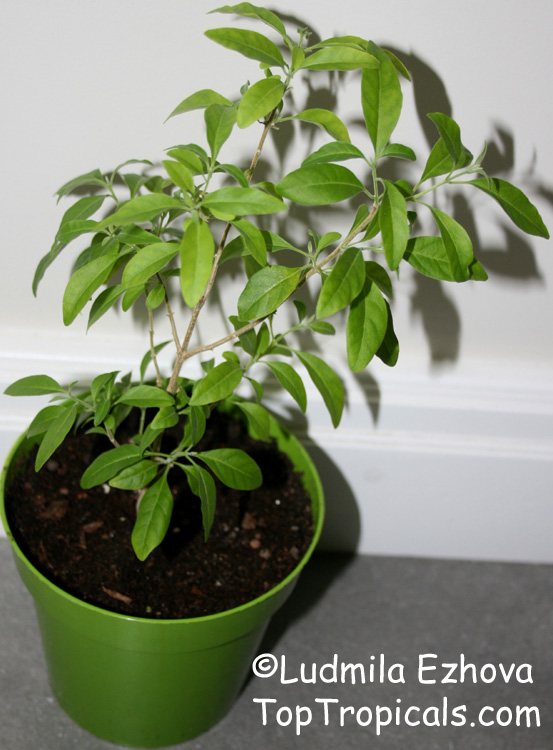

Clerodendrum heterophyllum
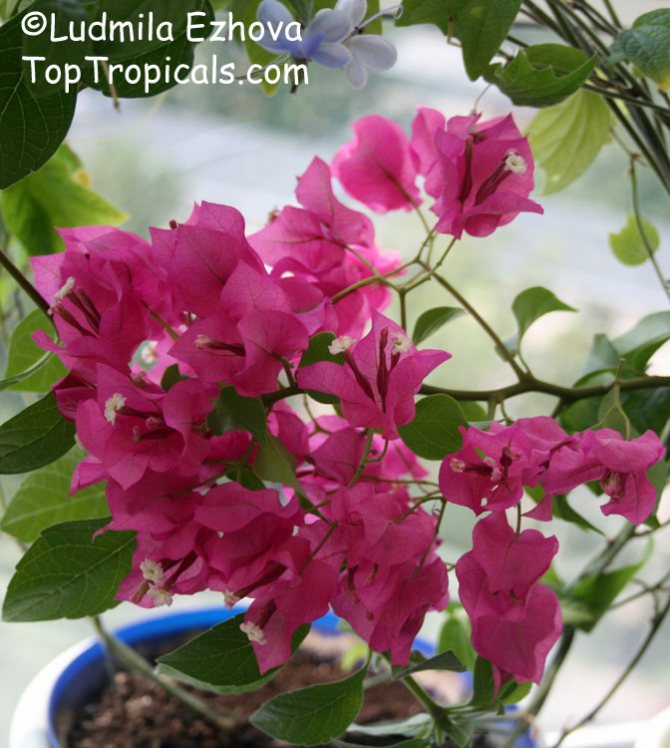

Bougainvillea glabra
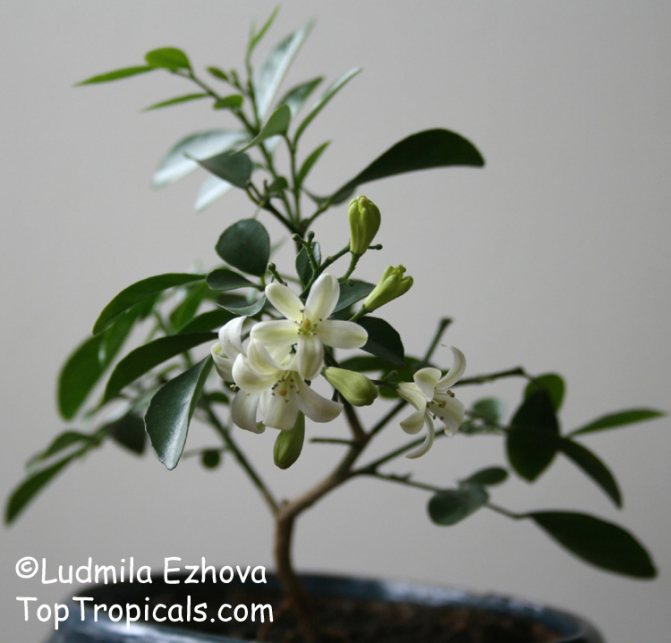

Murraya exotica
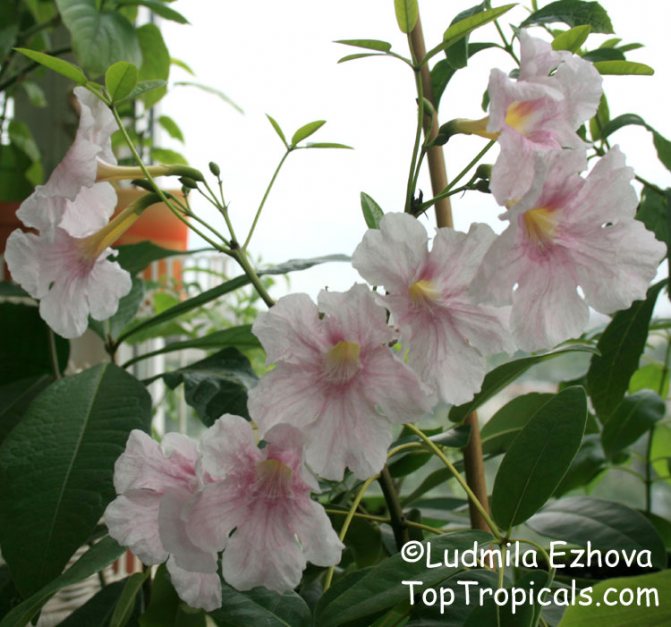

Tabebuia heterophylla
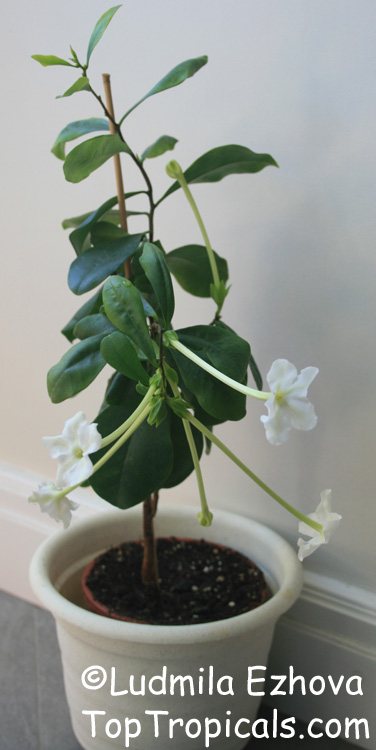

Brunfelsia americana
Lyudmila Yezhova is a native Petersburg woman. She has two children and a wonderful family. She is a HR manager by profession.He loves books, bowling, loves to travel and cannot imagine himself without communicating with friends.
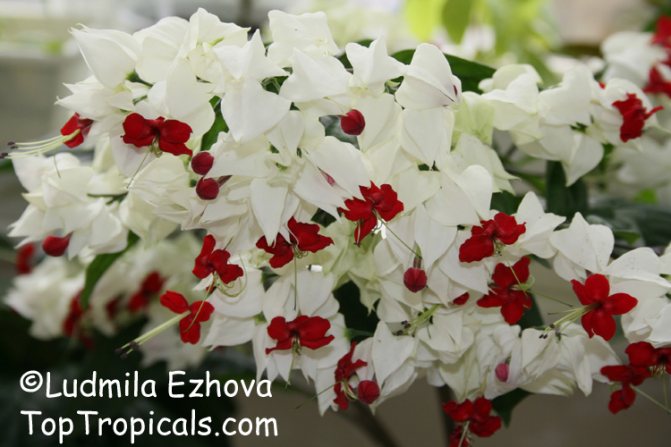

This flower in our house is the most beloved
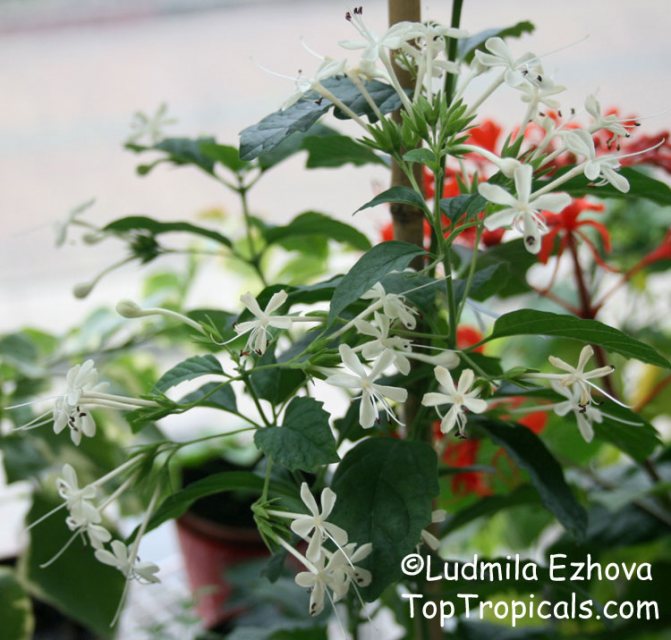

Clerodendrum calamitosum
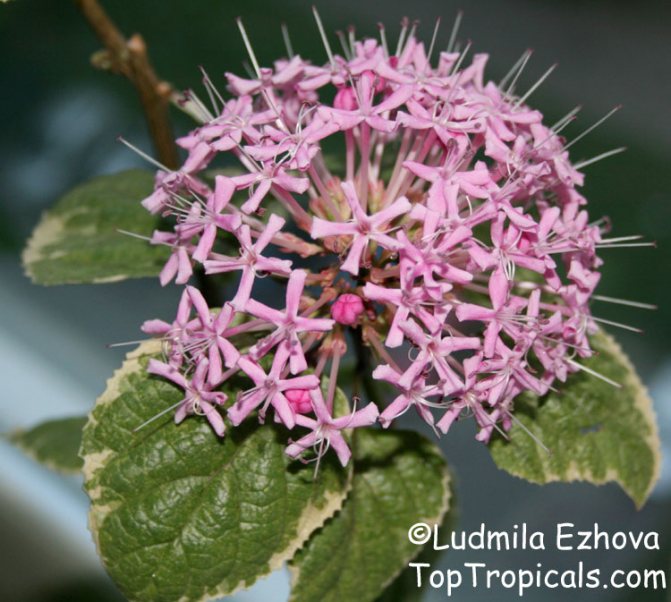

Clerodendrum bungei variegated reproduces by root babies
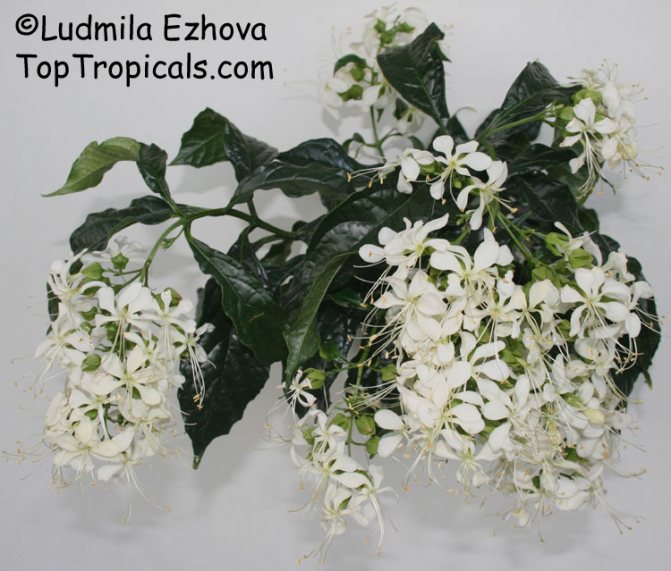

Clerodendrum wallichii is also called the Bride of the Veil
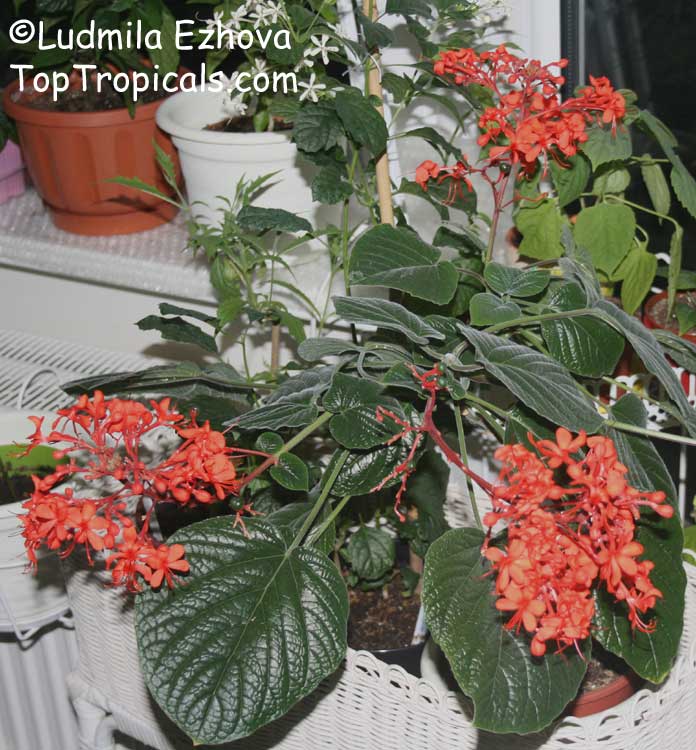

Clerodendrum speciosissimum
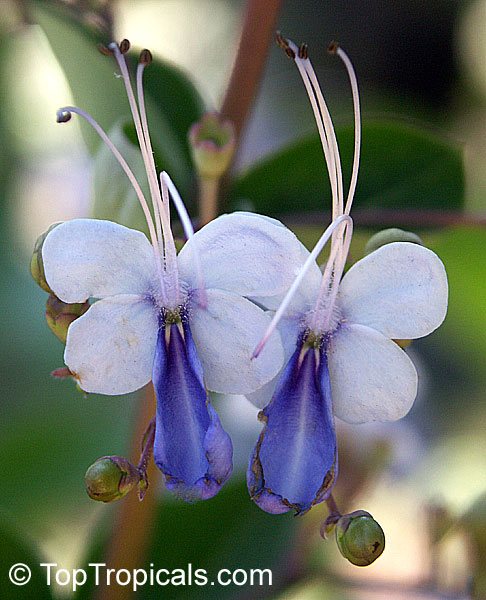

Clerodendrum ugandense flowers are called blue butterflies.
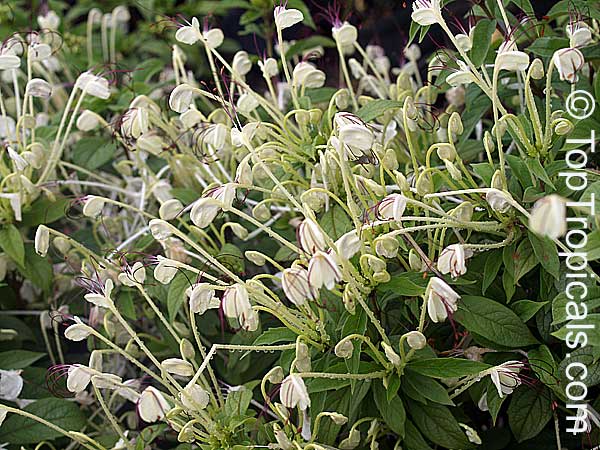

Clerodendrum incisum Macrosiphon - Musical note
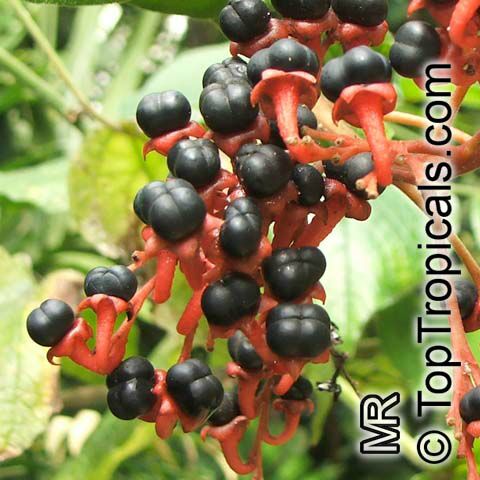

Clerodendrum speciosissimum fruits
I started to study plants seriously about two years ago. Her collection, consisting of more than 80 specimens, contains a lot of beautifully flowering tropical exoticism, since she has the opportunity to grow it - Lyudmila has a large two-level apartment, all windows of which are facing south. The ground floor of this bright and spacious apartment belongs to flowers. "My Winter Garden" - this is how the mistress of the house calls her flower possessions. Floriculture for Lyudmila is not just a hobby, it is rather a tender affection, she grows all plants only for herself and her loved ones.
The heart of this charming young woman belongs unconditionally to the clerodendrum, they make upaboutthe largest half of the entire flower kingdom. And there are reasons for this. But then she will tell about everything herself.
1. Grandma's flower
The first clerodendrum that I saw came from my grandmother twenty years ago. She, in turn, got this plant by a cuttings from relatives.
It was a small tree that constantly bloomed with flowers that I did not understand. It was surprising that the plant did not require special care. I never managed to get the name of this wonderful flower from my grandmother.
There was some strange, mystical connection between the plant and the grandmother. As soon as the grandmother began to get sick, the plant either turned yellow or threw off the leaves. When my grandmother died, her clerodendrum died a few days later.
I was left with a small twig, which was placed in the water, and surprisingly easily rooted. This is how my first Clerodendrum thomsoniae appeared.
It grew quickly, blooming every year with minimal pruning, and sometimes without it. Then we moved, and it turned out that the plant was forgotten in the old apartment.
When I came for him a month later, I saw a dry stem, on which a half-dead green twig was holding. I planted her ...
Since then, I have not parted with the plant. 15 years have passed.
Now it is a very large plant, grateful to me for taking care and taking care of it. Every year this veteran blooms from spring to autumn, and bloomed several times even in winter. Everything is beautiful in it: magnificent white-red flowers, and gorgeous, huge leaves.
He is very attached to me: if I leave for a long time, he throws off the leaves and stops growing. I have to prepare him in advance for my departure and, so to speak, negotiate with him. And it turns out, we always find a common language with him.
I call it my Destiny tree.
2. This is how the collection began
Wanting to learn more about my favorite plant, I started looking for information about it. And here's what we managed to find out.
Clerodendrum is a genus of flowering plants belonging to the Verbenaceae family. This genus consists of more than 150 species - shrubs, lianas and small trees - a specific feature of most of which are fragrant flowers and leaves, and each species has its own unique smell.
Clerodendrum has very beautiful flowers, the shape of the flower in almost all species looks like a butterfly.
However, in some clerodendrum, for example, Clerodendrum philippinum and Clerodendrum bungei, flowers have a different, no less interesting shape, reminiscent of exotic bouquets. In some species, the leaves are pubescent.
The homeland of these plants is a rather vast region covering tropical Africa and southern Asia, some species originate from the tropics of South America, the homeland of other species is scattered across the vast ocean expanses - the islands located north of Australia are considered their homeland.
Clerodendrum got its name from two Greek words: kleros - "chance" and dendron - "tree".In Southeast Asia, the leaves of these plants were considered healing, giving a chance to heal - hence the name.
After reading a lot of literature on clerodendrum, and seeing how many species there are in nature, I had a dream: to collect a collection of clerodendrum at home.
The conditions allowed - the southern windows and spaciousness were supposed to please the new inhabitants. The main thing remained: where to get these plants? However, it turned out that not everything is so bad, they could be bought or grown from seeds.
Clerodendrum paniculatum was the first to appear. It was bought in a small cut, but in triple copies. All three cuttings were planted in one pot. It was a pity to share them. Therefore, it was decided to intertwine all three trunks. So a gorgeous clerodendrum appeared, which grew by leaps and bounds.
The plant grew very large, with beautiful carved leaves, but I was very worried about the strange droplets that appeared on the inside of the leaf. What I just did not do with him, constantly suspecting the presence of all kinds of pests on him! I wiped it with household soap, and an alcohol solution, and treated it with Fitoverm.
After treatment, the droplets disappeared, but reappeared after a week. At the same time, the plant did not suffer, but looked healthy. After making sure that this was not a pest, she began to search for information about what it could be.
On one of the flower resources they helped: they said that on the back of the leaf of some species of clerodendrum, such as Clerodendrum wallichii, Clerodendrum paniculatum, Clerodendrum philippinum, Clerodendrum speciosissimum, there are stomata through which plants breathe. Thus, I learned another feature of my favorite plants.
The third in the collection was the Ugandan Clerodendrum (Clerodendrum ugandense). Like Clerodendrum paniculatum, it was also purchased in triplicate: a stalk, an adult plant that had never bloomed from the previous owner in five years, and a Dutchman freshly brought to a flower shop.
After a week of adaptation, an adult plant was cut off dramatically, after which fresh branches quickly grew and blossomed.
The Dutch Clerodendrum was well-formed, well-fed and blooming literally immediately after purchase.
The next acquisition was Clerodendrum incisum Macrosiphon. He came to me with a dry stick, which after a week of adaptation was also prone to pruning, after which the flower began to grow slowly.
For six months the plant suffered greatly from chlorosis, in the fight against which I, having placed the plant on a windowsill in direct sunlight, actively used the spraying of chlorous leaves with the preparation "Antichlorosis" by Master Tsvet. Musical notes blossomed after growing lush, healthy foliage over the course of a year. After the first flowering, this clerodendrum was heavily pruned.
Some representatives of my Winter Garden, I love them all very much!
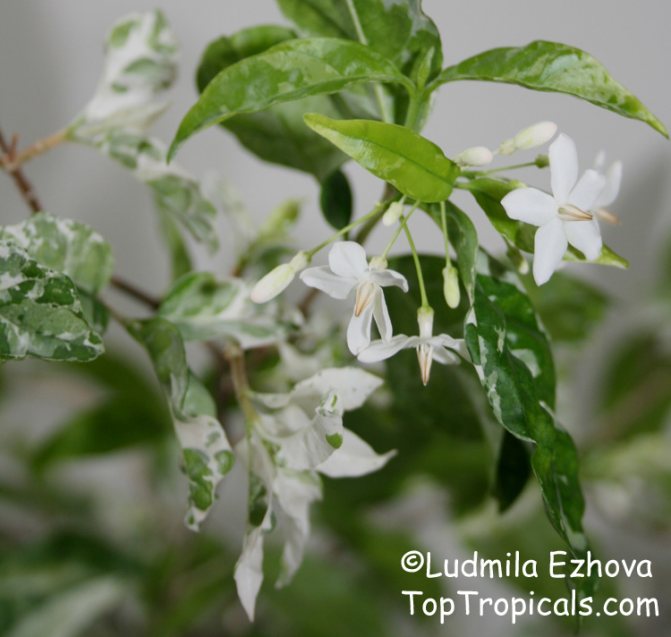

Wrightia religiosa variegated
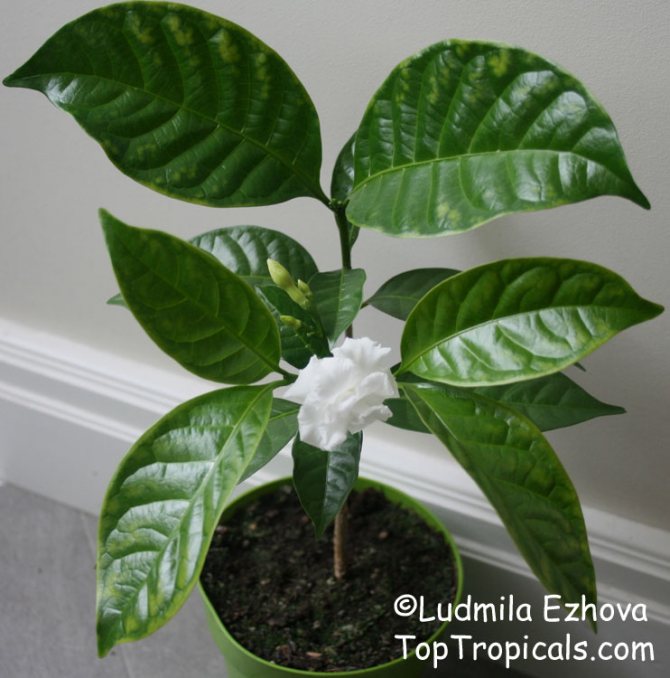

Tabernaemontana divaricata Flore Pleno


Then an adult was bought, picking up the buds of Clerodendrum philippinum, which immediately pleased with its flowering. The aroma of these delicate flowers, resembling small roses in their shape, is simply amazing!
Clerodendrum speciosissimum also came to me with a pitiful stick with living kidneys. After pruning, the plant began to grow rapidly, bloomed and continues to bloom. I have not yet subjected it to cuttings and pruning, because this bright handsome man is formed independently, but I had to work as a bee. After that, we managed to get a small harvest of berries from it.
Clerodendrum calamitosum was ordered from Moscow. This beautiful stalk bloomed in six months. The flowers are very fragrant, but unfortunately they don't last long.
I grew Clerodendrum wallichii from a dry twig, on which two chlorous leaves could barely hold. Cutting off this stick, she began to nurture, and the plant, albeit very slowly, began to grow. This species is very susceptible to chlorosis, both from an excess of sunlight and a lack of it.The flowers are very fragrant, the smell is most pronounced in the evening.
3. Useful practical advice
Based on my experience of growing clerodendrum in the northwestern region of Russia, I bring to your attention my observations and recommendations for caring for these plants:
- Clerodendrum need indirect sunlight;
- Mature plants require pruning in early spring;
- A cool wintering is recommended (but not required) for flowering. Those types of clerodendrons that reproduce by root babies can withstand temperatures down to -5C. In the event that a cool wintering is impossible, in the winter time it is necessary to reduce watering;
- If the leaves of the plant turn yellow in winter, they must be cut off without touching the trunk. In the spring, the trunk should be cut as short as possible, thereby provoking growth, and then abundant flowering;
- Plants need daily evening spraying;
- Adult plants in early spring can be cut in half with an earthen ball. After trimming the coma, do not water the plant for an hour;
- All types of clerodendrons root well in water. They take root faster in spring, slower in winter, but nevertheless they also take root;
- In case of chlorosis of the leaves, it is necessary to fertilize the leaf with iron-containing preparations (best in the autumn and winter seasons), in the summer with chlorosis, it is necessary to shade the plant from exposure to direct sunlight;
- Chlorous leaves need to be torn off, they will not turn green anyway;
- Optimal soil composition: sand + earth for decorative deciduous plants + vermiculite;
- Clerodendrum are susceptible to spider mites and whiteflies. Control measures - Sunmayt, Fitoverm;
- Of the devices that help not only clerodendrum, but other tropical plants to survive during a long, dark and cold winter, I use a heated floor, phyto-lamps with DNaZ Reflax 100W lamps and electronic ballasts, as well as a humidifier.
And the most important thing is that you need to love plants, then they will definitely give you all their beauty. Maybe you, like me, will also find your most important flower, which for you will become a plant of fate, which clerodendrum has become for me.
Here are some more photos from my Winter Garden, I love them all very much!
Clerodendrum: how to propagate by seed
They are usually purchased at a store or hand-picked. You also need to know that the longer the seeds lie idle, the harder it is for them to sprout. Therefore, it is advisable to sow, firstly, only new seeds, and, secondly, with a margin. The optimal time for sowing is at the end of winter. Planting pots must be prepared in advance.
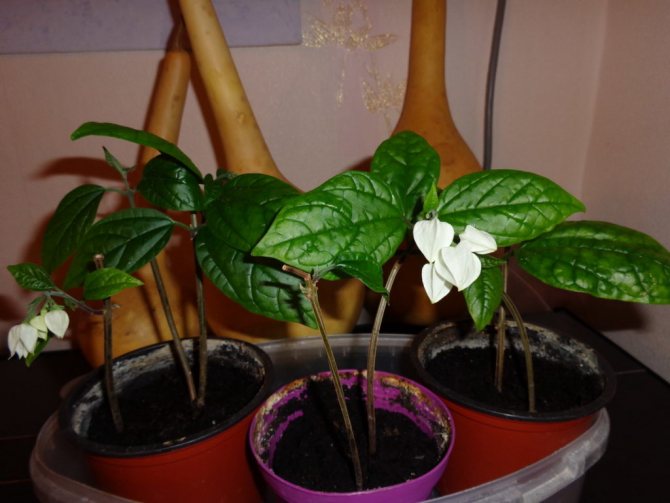

Planting process
Medium sized wooden crates, plastic containers and even glasses can be used. You also need to remember to make holes in the container to drain water. Now a few words about the soil in which the seeds will grow. It should be airy, nutritious and permeable. A mixture of two parts of turf soil, peat and river sand is prepared. Everything is mixed and processed. The composition is placed for twenty minutes in an oven at a temperature of one hundred and eighty degrees. After that, the mixture is allowed to cool, poured into planting containers and moistened abundantly. Then the seeds are sown. Now the container can be placed in the greenhouse or covered with glass. Condensate is collected in time.

